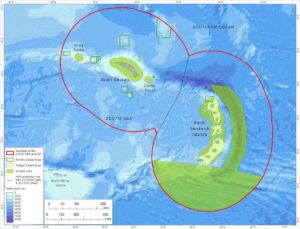Marine Protected Area
(The MPA data portal can be found here: MPA Data Portal)
The South Georgia and South Sandwich Islands Marine Protected Area (SGSSI-MPA) is one of the world’s largest MPAs, covering an area of 1.24 million km2 (an area 5 x larger than the UK). It was established in 2012 with the aim of conserving the rich marine biodiversity within the Territory’s maritime zone and provides a framework for our marine environmental management and research needs. Further enhancements were made in 2013 and in 2019 a suite of additional measures were introduced into law following recommendations arising from the first independent 5-year MPA review. Details of the new measures can be found within the legislation.
Our no take zones (NTZ), where all fishing activity is prohibited, cover 283,000km2 and include the most biodiverse regions of the seabed including all coastal waters of less than 100m depth as well as unique hydrothermal vent habitats and seamounts and trenches including the deepest part of the Southern Ocean (over 8000m deep in the South Sandwich trench). The NTZs, coupled with strict seasonal and spatial fishery management measures are designed to greatly reduce the overlap of foraging predator species including seals and penguins with the highly regulated fisheries.
Trawl fishing on the seabed is prohibited throughout the entire MPA along with any activities associated with the exploitation of hydrocarbons or minerals whilst the use and carriage of heavy fuel (HFO) by all vessels, which is already prohibited across over half of the MPA, will come into force across the whole MPA by 31 December 2020.
All fishing on the seafloor is prohibited across 94% of the MPA. Longline fishing for toothfish is limited to depths between 700- 2250 m covering less than 6% of the MPA area to conserve biodiverse seafloor habitats. The fishery is also restricted to just four months a year in winter, which has eliminated albatross bycatch in this high scoring Marine Stewardship Council (MSC) certified fishery. The South Georgia krill fishery is also confined to winter months when most species of krill feeding predators including penguins, seals and whales are absent or at much lower densities around South Georgia. No commercial krill fishing has taken place at the South Sandwich Islands for over 30 years when very small research catches were taken.
The MPA measures are enforced by the year-round presence of the Government’s patrol vessel Pharos SG in order to reduce the threat of pirate fishing (IUU) activity. This has been all but eliminated since the introduction of year-round maritime patrols in the 1990s but IUU remains a great threat to the region’s ecosystem. GSGSSI needs to remain vigilante at a time when 15-30% of global fish catches are estimated to come from IUU activity. In addition to routine and targeted satellite surveillance, intelligence is obtained from many sources including the licenced fishing fleet and is used extensively to support the patrol vessel operations and to target our MPA surveillance.
The MPA is subject to five yearly review to ensure that its measures continue to reflect the best available science. The first review concluded in late 2018 and resulted in the introduction of a range of new enhancements to the MPA as well as the development of a comprehensive data portal and research and monitoring plan funded through a UK Darwin Initiative grant. This will help inform GSGSSI at which areas further research should be targeted to assess the efficacy of the MPA measures over time. The data portal, research and monitoring plan and MPA management plan all highlight the extraordinary breadth and volume of science that contributed to the establishment of our MPA.


